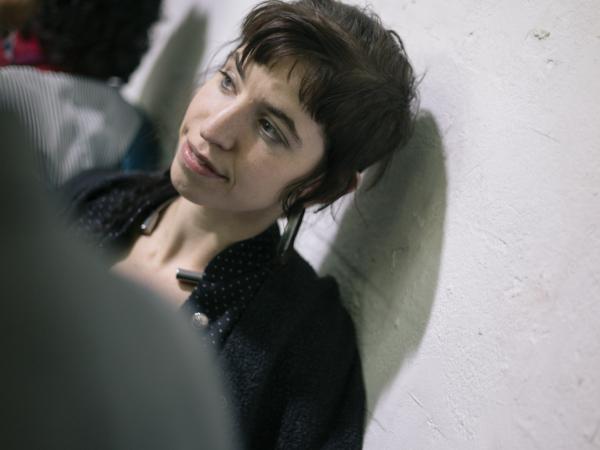One of the primary roles of art is to represent and help to define the natural and cultural identity of their time. Today, that identity is constantly growing and rapidly transformed by techno-scientific research. The epistemological and ethical aspects of the relationship between research and techno-scientific society are thus become the subject of increasing attention by contemporary artists.
In this complex multidisciplinary and transdisciplinary landscape, contemporary art is placed between the complex apparatus of techno-scientific research and society. "Art is the opportunity to highlight the taboos, the unspeakable, the unprovable, it is the metaphor most powerful man in an artificial world made of information flows, is a proliferation of energy in the infinite freedom of the imagination, is like a battlefield where there is a radical form of creation, has the task of exposing the problems and generate awareness. That contemporary art scene is described as our contemporary "art above all of contamination, no longer closed and" secure "in separate locations, an art that began to spread outside of the specialized channels, which creates places, directions, warps that has the ability to construct mental screens on which to project their wishes and neorganismi transformations, new cognitive situations, new extensions of the body, a dimension of art, the more alive, more extreme, the one that has taken a concept revolutionized what is meant by mutation of the bodies, bodies such as rebellion, new categories of human, transhuman, posthuman. So far science has not made major changes in our physical nature, although its effects have significantly altered some of the cultural behaviors established during the evolution of man, such as gender roles. Perhaps in the coming decades, questions relative to the body, mind, ego, become meaningless. New technologies, genetic engineering, artificial intelligence, cybernetics and virtual reality, are rapidly redefining the terms of the physical experience.
Contamination and mutation, these "places" that track changes in the new art, an art that blends into the skin and the mechanisms that trigger the transformation tools, language, body, period. "The scene of 'contemporary art presents us with a revolutionized concept of man and of his relationships, is a scene in which permanently changed the theoretical horizons of the new relations of human and nonhuman are interwoven with new artistic experiments. The idea of the first major mutations and aware of the human body come to us from the sixties, when hippies nudes they tested the first sexual revolution and the astronauts in their space walk weightless sanctioned the beginning of a new era of the human condition and unlimited possibilities. Also from the late sixties we receive, in addition to the certification body by the hippies, Body Art and also the first phenomena of replication of identity, the first followers of rock idols and omens of future "mental", of altered psychologies of possible worlds provided in the works of Burroughs, Ballard, and Dick, outlining a new human figure that includes the tools tecnocomunicativi. The Vanguards, with the actions of Dadaism and Surrealism, had made the mixture of different artistic languages, with the body art such bonds are strengthened and melt and the artist himself becomes a work of art, the body becomes absolute language, moldable material . If the body art was a practice of personal involvement, and physical body, the body that emerges from the eighties and nineties still carries with it the flesh and blood, but mixed with the alterations produced by nuclear waste, micro-technologies, AIDS, genetic engineering , media saturation, sexual alienation, population growth. The body becomes the border area of identity, hybridization between the self and other, between cultures and between the real and the virtual: the new era begins with a cancellation and alteration of the boundaries between inside and outside . According to Mario Perniola known lecturer and author of several books, including "The sex appeal of the inorganic" (1994), it fully supports "the idea that in the transition between the eighties and the nineties done something absolutely new and then this news is the fact that it can hardly be expressed in traditional terms. What changes is somehow the idea of art itself, in the sense that what emerges in a sense it is absolutely new experience, the dimension of which raises the question of what kind of experience it . In this case you really open to a new kind of experience where the relationship between organic and inorganic, between natural and artificial stands in completely new and completely different. In parallel with research on mutant body that has been the focus of research of the plastic arts in the '90s, the tecnoarti are kept inside with the organic theme of change untried hi-tech. The "post-human body" represented and exorcised from the plastic arts during these years is complex and threatening and the use of processes and elements of the field biogenetic allows designers to investigate and participate in and monitor what happens. Robots, cyborgs, made body "posthuman" by genetic engineering is already at work on diversion, recreation, modification of the original genes. One area that appeals (besides the wave of emotion before the first shocking results) on strong drives to overcome the limitations of the body, improve it, refine it and make it (of course) non-perishable, immortal. It prefigures the transition from the robot as a substitute (as well as a double), the Cyborg as a form of prostatic bio-mechanical technologies (as well as cross-over cultural) to "re-created body," and finally "created". The term "cyborg", which stands for "cybernetics organism", was taken from science fiction in the sixties to indicate the new man-machine hybrids, that is, humans modified by the addition of prosthetic mechanical or electromechanical, and sometimes completely beings but with artificial anthropomorphic, like the "aneroid", the "humanoid robots" or "surrogates". The image evoked by that word is that of a human being with artificial inserts in his body, such as mechanical arts, but it can also get to be entirely artificial beings that are human only in appearance. The cyborg refers to a relationship between man and technology that is changing, alludes to a similarity between man and machine that reporting of changes in size, logic and operation of the machine, but also the inevitable mutations in humans. What is difficult to understand is the right attitude to take towards the cyborg, the figure in the increasingly complex imaginary and real contemporaries, but one thing is certain, namely that hybridization with the artificial perspective is unavoidable, that one can not escape: the only choice we have is the meaning to be given to this perspective. In 1991, the critic and curator Jeffrey Deitch, New York presents a group coined a term "posthuman," will define an artistic movement and a movement of thought very specific and important, the basic concept of this idea is to overcome the limits biological. Now the man has the ability to intervene in the biological process at both ontogenetic and phylogenetic cognitive level, creating intelligences and synthetic prostheses. The passage is from an idea of the body as a physical identity limit the idea of a movable body as a support for an identity. Greatest exponent of the art posthuman is the Australian artist Stelarc, whose thinking is based on the idea of a biological body obsolete, which is improved with the mechanics and electronics. Materializing the idea that the prosthesis is no longer a lack but an excess, Stelarc is made implanting third mechanical arm on the fabric of one of its biological arm. As evidence of the changed conception of the body is mentioned here, a step by Tiziana Villani, taken from "Post-Fordist Lexicon", the text drafted by Adelino Zanini and Ubaldo Fadini: "The body as a place, area of relationships and power as performative is true border material of our time. Development of modern societies is a becoming of the body as "an instrument of performance." The body in its concreteness, in its finitude, is a threshold: threshold of time, illness, imperfection






Comments 0
Say something